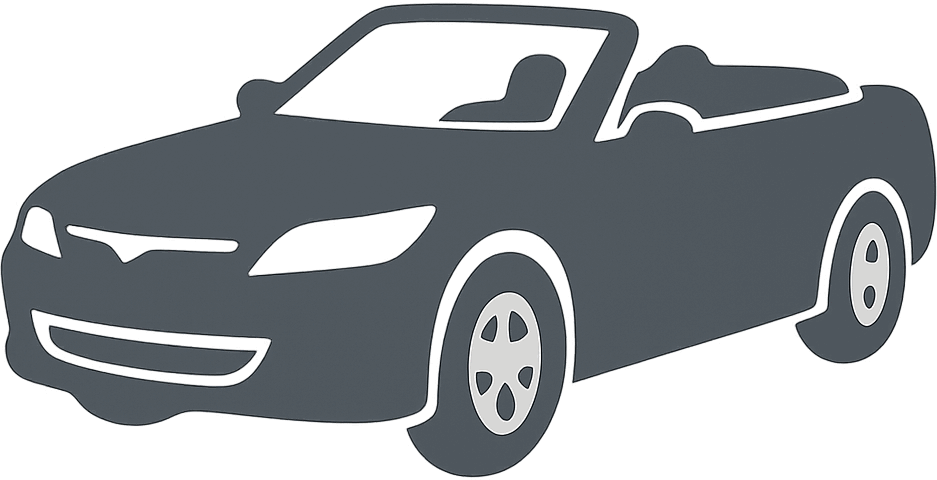 1996 De Tomaso Bigua Dimensions, Size & Specs
1996 De Tomaso Bigua Dimensions, Size & Specs
Measurements of the 1996 De Tomaso Bigua, engineered for optimal performance and comfort
| Dimensions | |
|---|---|
| Length: | 4194 mm165.1 in13.8 ft |
| Width: | 1900 mm74.8 in6.2 ft |
| Height: | 1275 mm50.2 in4.2 ft |
| Weight Specifications | |
| Curb Weight: | 1200 kg2646 lbs |
| Maximal permitted Weight: | 1400 kg3086 lbs |
| Tire Specifications | |
| Tire Size: |
|
The De Tomaso Bigua is a distinctive cabriolet produced between 1991 and 1998, with the 1996 model standing out for its sleek and sporty design. This Italian car measures 4194 mm (165.1 inches) in length, making it compact yet spacious enough for a comfortable driving experience. Its width spans 1900 mm (74.8 inches), providing a stable and broad stance on the road, which enhances cornering and overall vehicle dynamics. The car's height is a low 1275 mm (50.2 inches), giving it an aerodynamic profile typical of high-performance convertibles from that era. Weighing in at a curb weight of 1200 kg (2646 lbs), with a maximum weight capacity of 1400 kg (3086 lbs), the Bigua achieves an excellent balance between lightness and structural integrity, benefiting its agility and acceleration. Equipped with wide tires measuring 255/40 ZR17, it ensures optimal grip and handling, suitable for spirited driving. The Bigua's dimensions and weight categorize it as a compact yet potent cabriolet, positioned well for enthusiasts seeking a rare blend of classic Italian style and muscular presence. This vehicle remains a notable option for those comparing car sizes among sports convertibles from the 1990s, combining modest footprint with a formidable road presence.
Discover the standout features that make the 1996 De Tomaso Bigua a leader in its class
Have a question? Please check our knowledgebase first.
The De Tomaso Bigua produced from 1991 to 1998 is a sleek cabriolet with dimensions tailored for a sporty yet practical design. It measures 4194 mm (approximately 165.1 inches) in length, 1900 mm (74.8 inches) in width, and 1275 mm (50.2 inches) in height. These dimensions contribute to the car's dynamic appearance and allow for balanced handling characteristics, offering a comfortable yet exhilarating driving experience typical of De Tomaso vehicles.
The curb weight of the De Tomaso Bigua stands at 1200 kg (about 2646 lbs), which refers to the vehicle's weight without occupants or cargo but with all necessary operating fluids. The maximum allowable weight, or gross vehicle weight, is 1400 kg (roughly 3086 lbs). This limit ensures safe load capacity including passengers and cargo, emphasizing the Bigua's balance between lightweight construction and structural robustness for performance and safety.
The De Tomaso Bigua is equipped with tires sized 255/40 ZR17. This denotes a tire width of 255 mm, an aspect ratio (sidewall height) of 40% relative to the width, and a 17-inch diameter rim designed for high-speed capability indicated by the 'ZR' rating. These wide, low-profile tires enhance grip and responsiveness, providing the Bigua with excellent traction and stable cornering performance, essential for a sporty cabriolet designed for dynamic driving.
With its dimensions of 4194 mm (165.1 inches) in length, 1900 mm (74.8 inches) in width, and 1275 mm (50.2 inches) in height, the De Tomaso Bigua should generally fit into a standard garage. Most standard garage door openings are around 2.4 to 2.7 meters (94 to 106 inches) wide and about 2.1 to 2.4 meters (83 to 94 inches) high, so the Bigua's width and height are well within those limits. However, due to its width nearing 1.9 meters, careful parking might be required in narrower garages or ones with limited clearance.
The De Tomaso Bigua, built between 1991 and 1998, does not have a direct predecessor bearing the same model name, as it was a unique cabriolet developed during that era. However, compared to earlier De Tomaso sports cars like the Mangusta or Pantera, the Bigua's dimensions reflect a more modern approach with a modest length of 4194 mm (165.1 inches) and a wider stance at 1900 mm (74.8 inches). This size progression indicates a shift towards improved driver comfort, road presence, and stability compared to previous generations of De Tomaso vehicles.
In the 1990s sports cabriolet segment, the De Tomaso Bigua's dimensions were competitive. Its length of 4194 mm (165.1 inches) places it among the slightly smaller to mid-sized roadsters of that era, while its 1900 mm (74.8 inches) width is relatively wide, providing a stable footprint. For example, compared to contemporaries like the BMW Z3 or Porsche 911 Cabriolet, the Bigua offers a wider stance but is somewhat shorter in length. This balance of size contributed to its distinct handling characteristics and unique presence on the road, combining Italian design flair with practical sports car proportions.
The De Tomaso Bigua, with a height of 1275 mm (50.2 inches), offers a relatively low-profile cabin typical of performance cabriolets, designed to minimize aerodynamic drag and enhance the sporty feel. The interior was crafted to balance driver and passenger comfort with the sleek exterior, featuring enough headroom and legroom for most occupants while maintaining a compact, driver-focused environment. The low cabin height emphasizes a close-to-the-road driving sensation, a hallmark of Italian sports car design.
While specific ground clearance data for the De Tomaso Bigua is not commonly detailed, given its vehicle type and design as a sports cabriolet with low height (1275 mm/50.2 inches), it is expected to have a relatively low ground clearance. This low clearance supports better aerodynamics and handling stability but may limit usability on uneven roads or speed bumps. Owners typically need to be cautious when navigating steep driveways or rough terrain, as is common with performance-oriented roadsters.
Weighing in at a curb weight of 1200 kg (2646 lbs), the De Tomaso Bigua benefits from a relatively light body for a cabriolet of its time. This lower weight contributes positively to acceleration, braking, and cornering responsiveness, making the driving experience more agile and engaging. The car’s lightweight structure, combined with its wide tires and sports suspension, enhances maneuverability and overall performance, aligning with De Tomaso's focus on sporty, driver-centric vehicles.
The De Tomaso Bigua is notable for its combination of Italian styling with performance engineering. As a cabriolet, it offers open-top driving pleasure combined with a sleek and aerodynamic body measuring 4194 mm in length and 1900 mm in width. Its sporty nature is emphasized by wide 255/40 ZR17 tires and a lightweight design at 1200 kg curb weight. These attributes contribute to responsive handling and a distinctive road presence. The Bigua stands out for blending luxury with performance, catering to enthusiasts who appreciate exclusive sports cars from the 1990s.
